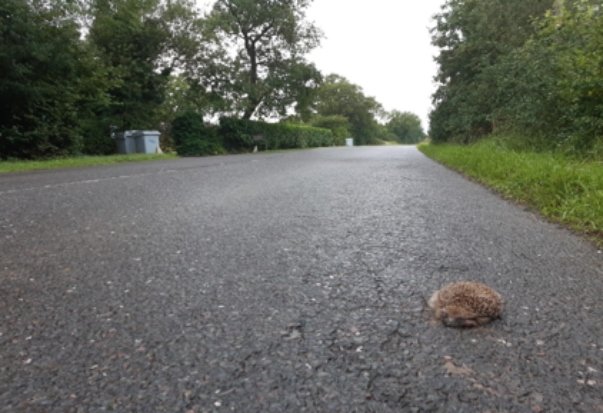From genes to populations: the multi-faceted impacts of road mortality on European hedgehogs and potential mitigation solutions
Written By Lauren Moore
PhD candidate, School of Animal, Rural and Environmental Sciences, Nottingham Trent University
18th January 2022
Europe is already probably the most fragmented continent due to transport infrastructure, and these road networks continue to expand rapidly. Hedgehogs, which are declining across Europe, are often the most frequently recorded mammal in both citizen science and expert roadkill surveys. We performed an extensive review of the existing literature on hedgehog-vehicle collisions to 1) assess the impacts of road mortality on population viability, 2) identify potential mitigation solutions; and 3) identify opportunities for future research.
Diverse impacts at the population, individual and genetic levels
Road mortality is a key consideration in population ecology due to its direct influence on vital rates. Moreover, cost-effective mitigation should be guided by comprehensive, population-level assessments. Therefore, investigating the population-level impacts of road mortality is of both theoretical and applied importance. It remains difficult, however, because survival probabilities depend on a complex set of interrelated factors, such as population size, reproductive output and immigration and emigration rates. Our review collated data from several studies that reported raw roadkill counts of hedgehogs, evidencing an average 0.001–3.65 hedgehog casualties/km/year for all European species across several European countries. For one species, the West European hedgehog, 3-30% of local and total (nationwide) populations are reportedly killed annually on roads. Smaller roads have the greatest mortality rates and reproductively active males are the most common victims. However, females are most likely to be involved in traffic collisions in autumn after intensive natal care as their net-movement increases to build fat reserves for hibernation.
Although road mortality can deplete populations directly, our review also highlighted that it can also contribute to population fragmentation, similar to the barrier effects from roads and road avoidance behaviour. Road-induced restrictions to gene flow have been shown to affect the genetic diversity within and between hedgehog populations in several European cities. However, the hedgehog’s promiscuous mating system and ability for heteropaternal superfecundity (a litter fertilised by different males) may partly counteract the genetic effects of isolation.
Photo: Lauren Moore
Mitigating hedgehog road mortality remains challenging and untested
As road construction and traffic volumes continue to grow, accommodating the increase in human activity without jeopardising the viability of wild populations remains a major challenge. We identified four mitigation categories for hedgehog road mortality:
Road crossing structures – Although studies report varying levels of use of road tunnels and overpasses by hedgehogs, they have been shown to frequent tunnels with a greater openness ratio (short in length, high and wide) nearer urban areas.
Traffic calming measures - Smaller-scale traffic calming measures such as speed bumps, speed restrictions and warning signs that increase driver awareness may be effective given that hedgehogs frequently attempt to cross quieter roads.
Habitat management - Additional mitigation possibilities include managing roadside habitats by increasing habitat quality, local connectivity and changing road verge management. These improve the core habitat and allow individuals to locate sufficient resources whilst crossing fewer roads.
Road configuration - Previous simulation studies have reported that hedgehog road mortality rates and population persistence were improved when traffic volume was spread over a large number of roads, rather than concentrated on fewer roads. Surprisingly, this contrasts with results for several other species and reinforces the significance of whole-landscape planning.
However, the efficacy of road mitigation measures for hedgehogs, and wildlife more generally, is rarely tested. This poses significant constraints on justifying mitigation efforts and adapting strategies for maximum benefit.
Photo: Lauren Moore
An urgent need for population-level research
We noted that, to date, only a handful of studies have included the population context needed to examine road mortality impacts on conservation-relevant endpoints, such as population viability. Future research into impacts on a population’s intrinsic growth rate and the sensitivity of population growth curves to sex- and age-specific road mortality is required. This review highlights the importance of long-term monitoring and robust experimental design for effective decision-making by conservation practitioners and policy makers.
Author information:
Lauren Moore, PhD candidate, School of Animal, Rural and Environmental Sciences, Nottingham Trent University, Southwell, NG25 0QF, Nottinghamshire, UK
Source:
Moore, L.J.; Petrovan, S.O.; Baker, P.J.; Bates, A.J.; Hicks, H.L.; Perkins, S.E.; Yarnell, R.W. (2020). Impacts and Potential Mitigation of Road Mortality for Hedgehogs in Europe. Animals 10, 1523. https://doi.org/10.3390/ani10091523
Editor:
Sophia Cooke & Rodney van der Ree
Cite this summary:
Moore, L. (2022). From genes to populations: the multi-faceted impacts of road mortality on European hedgehogs and potential mitigation solutions. Edited by Cooke, S. & van der Ree, R. TransportEcology.info, Accessed at: https://transportecology.info/research/european-hedgehogs-road-mortality-mitigation [Date accessed].



